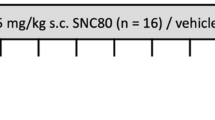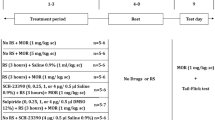Abstract
The aim of this study was to investigate the possible involvement of the mu-opioid system on the learned-helplessness paradigm, an experimental model of depression, in rats. In this test, rats were first exposed to inescapable foot-shocks (IS); 48 h later, they were submitted to a daily shuttle-box session (30 trials) for 3 consecutive days. Avoidance responses, escape failures and animal activity during each intertrial interval were recorded. Twice daily injections of morphine (0.25–8 mg/kg per day, SC), a mu-opioid agonist, reduced the increased escape failures induced by IS, as did tricyclic antidepressants. Significantly higher intertrial activity was observed in rats treated with morphine (2–8 mg/kg per day) compared with their associated control groups. Naloxone (1 and 2 mg/kg, IP), a mu-opioid antagonist, injected 10 min before each shuttle-box session impaired escape behavior in non-stressed rats and worsened the escape deficit induced by IS. Morphine-induced improvement of escape behavior and increase in intertrial activity were clearly reversed by a low inactive dose of naloxone (0.5 mg/kg). These results suggest that mu-opioid receptor mediation is involved in the deleterious effects of uncontrollable stress.
Similar content being viewed by others
References
Akil H, Watson SJ, Young E, Lewis ME, Khachaturian H, Walker JM (1984) Endogenous opioids: biology and function. Ann Rev Neurosci 7:223–255
Akil H, Young E, Walker JM, Watson SJ (1986) The many possible roles of opioids and related peptides in stress-induced analgesia. Ann NY Acad Sci 467:140–153
American Psychiatric Association (1987) Diagnostic and statistical manual of mental disorders, DSM III-R, Third Edition Revised. American Psychiatric Association, Washington DC
Anisman H, Ritch M, Sklar LS (1981) Noradrenergic and dopaminergic interactions in escape behavior: analysis of uncontrollable stress effects. Psychopharmacology 74:263–268
Berger A, Nemeroff CB (1987) Opioid peptides in affective disorders. In: Meltzer HY (ed) The third generation of progress (Psychopharmacology, chapter 63). Raven Press, New York, pp 637–646
Cavoy A, Ennaceur A, Delacour J (1988) Effects of piracetam on learned helplessness in rats. Physiol Behav 42:545–549
Costall B, Jones B.J., Kelly ME, Naylor RJ (1989) Exploration of mice in a black and white test box: validation as a model of anxiety. Pharmacol Biochem Behav 32 [3]:777–785
Drugan RC, Maïer SF (1983) Analgesic and opioid involvement in the shock elicited activity and escape deficits produced by inescapable shock. Learn Motiv 14:30–47
Drugan RC, Ryan SM, Minor TR, Maier SF (1985) Librium prevents the analgesia and shuttlebox escape deficit typically observed following inescapable shock. Pharmacol Biochem Behav 21 [5]:749–754
Edwards E, Kornrich W, Houtten PV, Henn FA (1992) Presynaptic serotonin mechanisms in rats subjected to inescapable shock. Neuropharmacology 31 [4]:323–330
Eixtein I, Pickar D, Gold MS, Gold PW, Pottash AC, Sweeney DR, Ross RJ, Rebard R, Martin D, Goodwin FK (1981) Methadone and morphine in depression. Pharmacol Bull 17:29–33
Emrich HM (1982) A possible role of opioid substances in depression. In: Costa E, Racagni G (eds) Typical and atypical antidepressants: clinical practice (advances in biochemical psychopharmacology, vol.32). Raven Press, New York, 77–83
Geoffroy M, Christensen AV (1993) Psychomotor stimulants versus antidepressants in the learned helplessness model of depression. Drug Dev Res 29:48–55
Giral P, Martin P, Soubrié P, Simon P (1988) Reversal of helpless behavior in rats by putative 5-HT1A agonists. Biol Psychiatry 23:237–242
Glazer HI, Weiss JM (1976) Long-term and transitory interference effects. J Exp Psychol Anim Behav Proc 2 [3]:191–201
Gysling K, Wang RY (1983) Morphine-induced activation of A10 dopamine neurons in the rat. Brain Res 277:119–127
Harris JC (1989) Experimental animal modeling of depression and anxiety. Psychiatr Clin N Am 12 [4]:815–835
Hemingway RB, Reigle TG (1987) The involvement of endogenous opiate systems in learned-helplessness and stress-induced analgesia. Psychopharmacology 93:353–357
Hughes J (1983) Opioid peptides. BMJ 39:1–95
Jackson RL, Maier SF, Rapaport PM (1978) Exposure to inescapable shock produces both inactivity and associative deficits in the rat. Learn Motiv 9:68–98
Janak PH, Manly JJ, Martinez JL (1994) [Leu]enkephalin enhances active avoidance conditioning in rats and mice. Neuropsychopharmacology 10 [1]:53–60
Katoh A, Nabeshima T, Kameyama T (1990) Behavioral changes induced by stressful situations: effects of enkephalins, dynorphin, and their interaction. J Pharmacol Exp Ther 253 [2]:600–607
Khachaturian H, Lewis ME, Schäfer MKH, Satson SJ (1985) Anatomy of the CNS opioid systems. Trends Neurol Sci 8:111–119
Koob GF (1992) drug of abuse: anatomy, pharmacology and function of reward pathways. Trends Pharmacol Sci 13:177–184
Levine JD, Feldmesser M, Tecott L, Gordon NC (1984) Pain-induced vocalization in the rat and its modification by pharmacological agents. Brain Res 296:121–127
Leyton M, Stewart J (1990) Preesposure to foot-shock sensitizes the locomotor response to subsequent systemic morphine and intranucleus accumbens amphetamine. Pharmacol Biochem Behav 37:303–310
Mac Cubbin JA, Kizer JS, Lipton MA (1984) Naltrexone prevents footshock-induced performance deficit in rats. Life Sci. 34:2057–2066
Magnus-Ellenbroek B, Havemann-Reinecke U (1993) Morphine-induced hyperactivity in rats — a rebound effect? Naunyn-Schmiedeberg's Arch Pharmacol 347:635–642
Mah C, Suissa A, Anisman H (1980) Dissociation of antinociception and escape deficits induced by stress in mice. J Comp Physiol Psychol 94 (6):1160–1171
Maier SF, Seligman MEP (1976) Learned-helplessness: theory and evidence. J Exp Psychol Gen 105 [1]:3–46
Martin P, Soubrié P, Simon P (1986) Noradrenergic and opioid mediation of tricyclic-induced reversal of escape deficits caused by inescapable shock pretreatment in rats. Psychoparmcology 90:90–94
Matsumoto M, Yoshioka M, Togashi H, Hirokami M, Tochihara M (1994) Mu-opioid receptors modulate noradrenaline release from the rat hippocampus as measured by brain microdialysis Brain Res 636:1–8
Morphy MA, Fava GA, Sonino N (1993) β-Endorphin responsiveness in depression. Arch Gen Psychiatry (letter) 50:406
Overmier JB, Seligman MP (1967) Effects of inescapable shock upon subsequent escape and avoidance learning. J Comp Physiol Psychol 63:23–33
Pickar D, Davis GC, Schulz SC, Eixtein I, Wagner R, Naber D, Gold PW, Van Kammen DP, Goodwin FK (1981) Behavioral and biological effects of acute beta-endorphin injection in scizophrenic and depressed patients. Am J Psychiatry 138:160–166
Pollard GT, Howard JL (1986) The staircase test: some evidence of non-specificity for anxiolytic. Psychopharmacology 89 [1]:14–19
Sherman AD, Sacquitne JL, Petty F (1982) Specificity of learned helplessness model of depression. Pharmacol Biochem Behav 16:449–454
Stengaard-Pedersen K, Schou M (1985) Opioid peptides and receptors in relation to affective illness. Effects of desipramine and lithium on opioid receptors in rat brain. Acta Pharmacol Toxicol 56 [1]:170–179
Tejedor-Real P, Mico JA, Maldonado R, Roques BP, Gibert-Rahola J (1993) Effect of mixed (RB 38A) and selective (RB 38B) inhibitors of enkephalin degrading enzymes on a model of depression in the rat. Biol Psychiatry 34:100–107
Thiebot MH, Martin P, Puech AJ (1992) Animal behavioral studies in the evaluation of antidepressant drugs. Br J Psychiatry 160 [suppl. 15]:44–50
Whitehouse WG, Walker J, Margules DL, Bersh PJ (1983) Opiate antagonists overcome the learned helplessness effect but impair competent escape performance. Physiol Behav 30:731–734
Willner P (1986) Validition criteria for animal models of human disorders: learned helplessness as a paradigm case. Prog Neuropsychopharmacol Biol Psychiatry 10:677–690
Willner P (1990) Animal models of depression: an overview. Pharmac Ther 45:425–455
Yoshioka M, Matsumoto M, Togashi H, Smith CB, Saito H (1993) Opioid receptor regulation of 5-hydroxytryptamine release from the rat hippocampus measured by in vivo microdialysis. Brain Res 613:74–79
Author information
Authors and Affiliations
Rights and permissions
About this article
Cite this article
Besson, A., Privat, A.M., Fialip, J. et al. Effects of morphine, naloxone and their interaction in the learned-helplessness paradigm in rats. Psychopharmacology 123, 71–78 (1996). https://doi.org/10.1007/BF02246283
Received:
Revised:
Issue Date:
DOI: https://doi.org/10.1007/BF02246283




